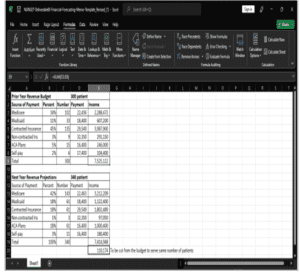Financial Forecasting Memo
To: Nurse Manager-Orthopedics
From: Jessica Durkin
Date: August 7, 2023
Re: Financial Forecast
Part One – Financial Forecasting Model
| Prior Year Revenue Budget | 300 patients | |||
| Source of Payment | Per cent | Number | Payment | Income |
| Medicare | 34% | 102 | 22,436 | 2,288,472 |
| Medicaid | 11% | 33 | 18,400 | 607,200 |
| Contracted Insurance | 45% | 135 | 29,540 | 3,987,900 |
| Non-contracted Insurance | 3% | 9 | 32,350 | 291,150 |
| ACA Plans | 5% | 15 | 16,400 | 246,000 |
| Self-pay | 2% | 6 | 17,400 | 104,400 |
| Total | 100% | 300 | 7,525,122 | |
| Next Year Revenue Projections | 340 patients | |||
| Source of Payment | Per cent | Number | Payment | Income |
| Medicare | 42% | 143 | 22,463 | 3,212,209 |
| Medicaid | 18% | 61 | 18,400 | 1,122,400 |
| Contracted Insurance | 18% | 61 | 29,549 | 1,802,489 |
| Non-contracted Insurance | 1% | 3 | 32,350 | 97,050 |
| ACA Plans | 18% | 61 | 16,400 | 1,000,400 |
| Self-pay | 3% | 11 | 16,400 | 180,400 |
| Total | 100% | 340 | 7,414,948 | |
| To be cut from the budget to serve the same number of patients | 110,174 | |||
Part Two – Financial Forecasting
Your request was well received. The number of hip replacements is expected to increase to 340 next year from the current 300 as well as the payer mix. The financial and payer mix projections show that Medicare and Medicaid payments are expected to increase by 8% and 7%, respectively, in the next year. Payments under ACA Plans and self-pay are also expected to increase from the current 5% to 18% and 2% to 3%, respectively. However, a significant decrease is expected from contracted insurance by 27%, and non-contracted insurance will drop from the current 3% to 1% in the next year. Due to this change in the payer mix, income is expected to drop by 1.464% from the current $7,525,122 to $7,414,948 next year.
The changes in the payer mix will result in a loss of $110,174. This means an adjustment to next year’s budget is necessary. Although an increase in the number of patients served is projected, as well as an increase in Medicare and Medicaid, ACA Plans, and self-pay payments, it is not enough to offset the loss from lost high-paying contracted and non-contracted insurance. Basically, a change in the payer mix leads to significant variations in revenue generation (Rascoe et al., 2020). As evidenced in trends in hospital incomes between 2019-2022, the changes in the payer mix, especially overdependency on Medicare/Medicare and loss of other insurers and payer types such as self-pay, contribute to lower financial performance (Melnick & Maerki, 2023).
To compensate for the estimated 1.5% drop in the next year’s income, I request you to consider the following recommendations:
Renegotiate with suppliers of essential supplies for the orthopedics unit, including medical supplies, implants, and equipment.
Benchmark against the competitor. Benchmarking against competitors is one of the ways to evaluate a hospital service quality (Ulkhaq, 2018) and a motivation towards better performance in healthcare (Bevan et al., 2019).
Eliminate unnecessary expenditures by allocating the unit’s resources according to patients’ specific needs.
Educate the unit’s staff to improve their effectiveness and efficiency in the use of available resources. Staff efficiency and effectiveness are top determinants of hospital performance (Carini et al., 2020).
Thank you for your consideration.
Regards,
Jessica
References
Bevan, G., Evans, A., & Nuti, S. (2019). Reputations count: Why benchmarking performance is improving health care across the world. Health Economics, Policy and Law, 14(2). https://doi.org/10.1017/S1744133117000561
Carini, E., Gabutti, I., Frisicale, E. M., Di Pilla, A., Pezzullo, A. M., de Waure, C., Cicchetti, A., Boccia, S., & Specchia, M. L. (2020). Assessing hospital performance indicators. What dimensions? Evidence from an umbrella review. BMC Health Services Research, 20(1), 1–13. https://doi.org/10.1186/S12913-020-05879-Y/TABLES/2
Melnick, G., & Maerki, S. (2023). Heading for an acute crisis? Utilization, revenue, expenses, and margins in California’s hospitals, 2019–22. California Health Care Foundation.
Rascoe, A. S., Flanagan, C. D., Kim, C. Y., & Vallier, H. A. (2020). Variations in revenue generation for the care of orthopedic trauma patients. Journal of the American Academy of Orthopaedic Surgeons, 28(4), E151–E157. https://doi.org/10.5435/JAAOS-D-17-00871
Ulkhaq, M. M. (2018). Evaluating Hospital Service Quality: An application of CZSQ and CZIPA. International Journal of Innovation, Management and Technology. https://doi.org/10.18178/
ORDER A PLAGIARISM-FREE PAPER HERE
We’ll write everything from scratch
Question
Instructions
Prepare a financial forecasting memo to your nurse manager that:
Part One – Financial Forecasting Model
Contains a completed financial forecasting model by downloading:
NUR4327-Deliverable03-Financial-Forecasting-Memo-Template_Revised.xlsx
Calculate the income projected from each payer source and total for the year to compare next year’s revenue to this year’s revenue.

Financial Forecasting Memo
Provide your nurse manager with your estimates on the increase/ decrease in revenue for next year’s budgeting.
Part Two – Financial Forecasting Memo
Explains how the change in payer mix will impact the overall projected revenue of the unit.
Describes the financial impact of a changing payer mix.
Lists recommendations for the manager to consider in expenses so that the budget will balance as neutral.
Provides stated ideas with professional language and attribution for credible sources with correct APA citation, spelling, and grammar in the memo.


